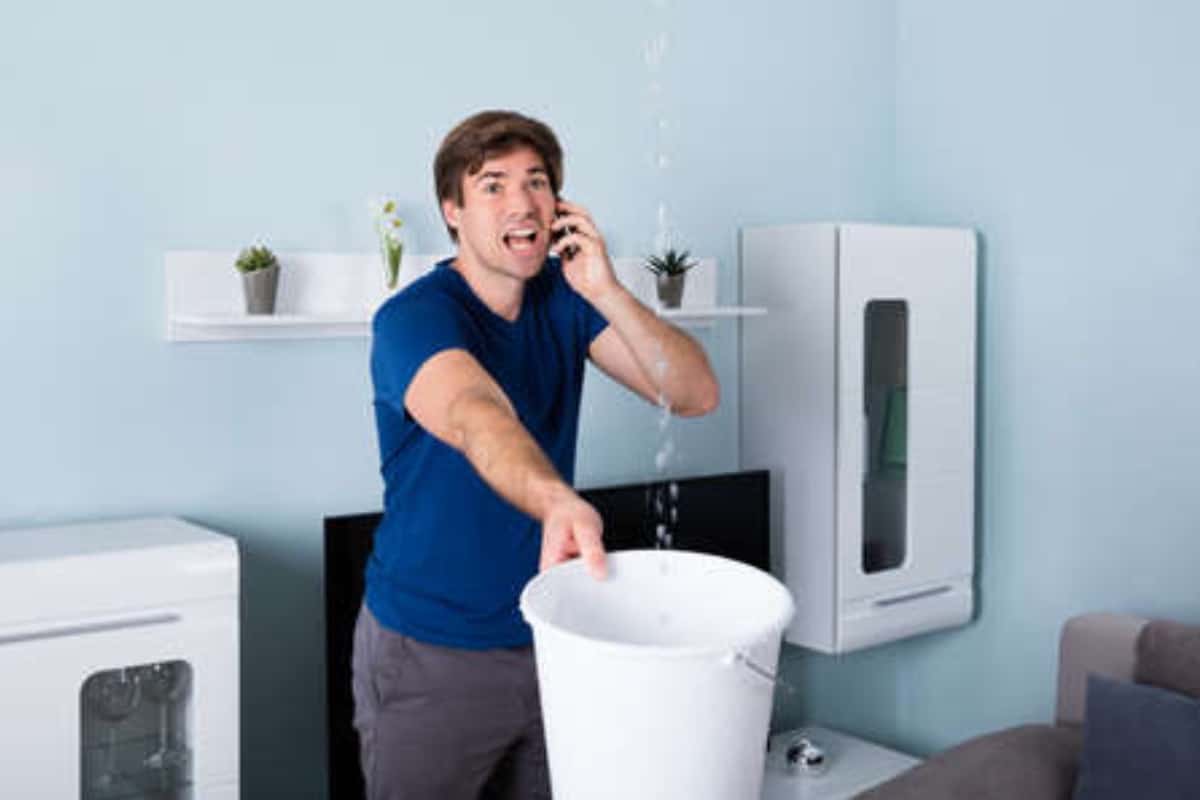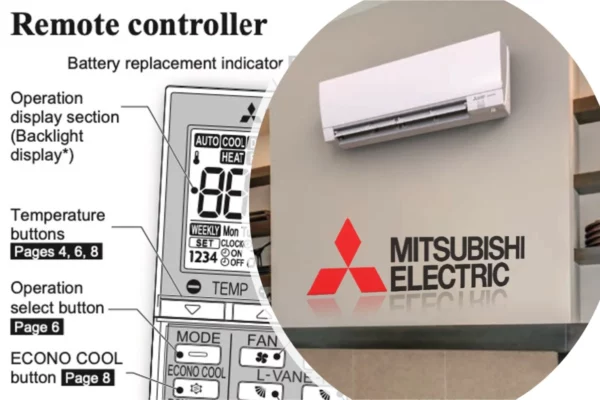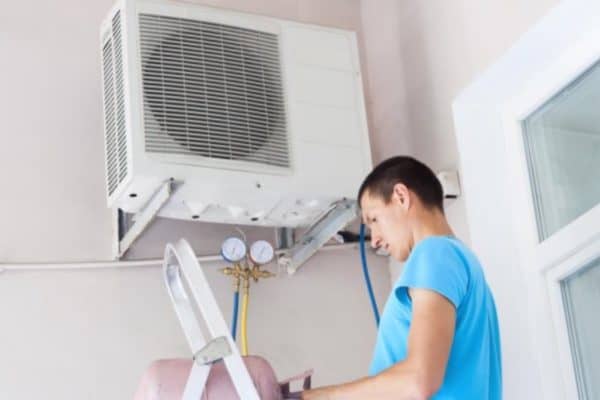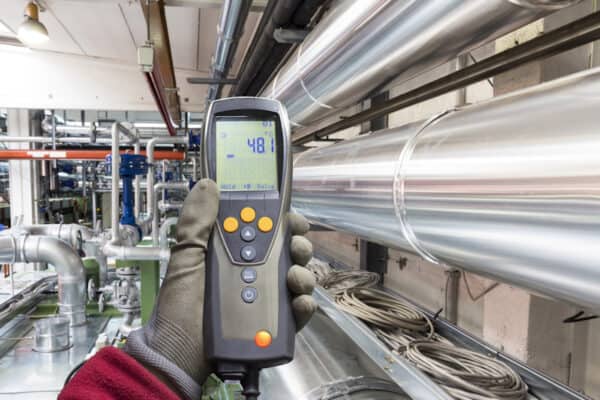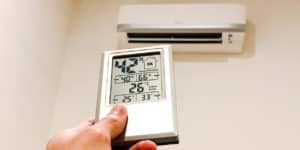AC Leaking Water: Symptoms, Causes, Fix & Prevention
An air conditioner leaking water can have many causes. We need to know the symptoms of the water leaking in order to identify the root cause and fix it.
I organized 8 types of air conditioner water leaking problems, covering from the most common problem to the least common problem found in both residential and commercial air conditioning systems.
We should identify the root cause, fix the problem, and take action to prevent it from happening again. It will save us money, time, and energy as well as not getting frustrated over the air conditioner water leaking.
1. Clogged Drain Pipe
A clogged drain pipe is the most common cause of air conditioners water leaking.
Symptoms
- Water leaking continuously from the indoor unit – Condensate water overflowed at the indoor unit. Water leaking continues even after the air conditioner is turned off. An example of it as follow:
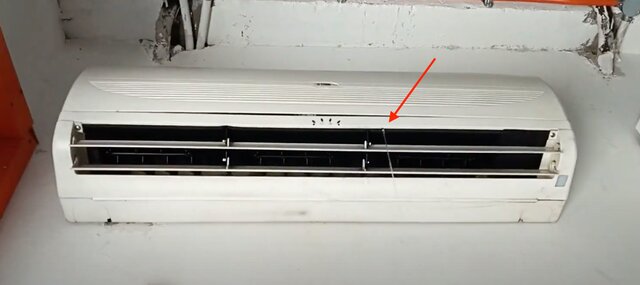
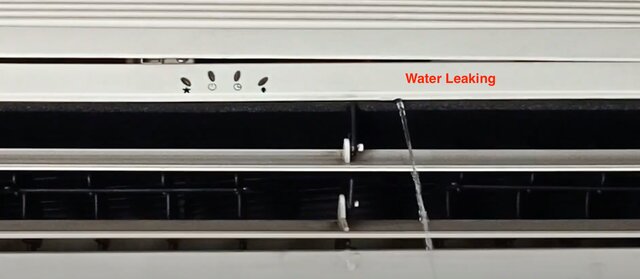
Causes
- Insufficient pipe gradient – Condensate water produced by the air conditioner was discharging too slowly, allowing time for slimes to build up inside the drain pipe and eventually clogged the drain pipe.
- Drain pipe outlet is blocked – Outlet of the drain pipe is blocked by foreign objects such as stone and sand. Besides, if the outlet is submerged in water, it’ll stop the condensate water from discharging too.
- Intermediate pipe is blocked – A section of the concealed drain pipe may be blocked due to floor/wall collapsed.
How to Fix
- Purge the drain pipe – Use high-pressure gas such as nitrogen to purge the drain pipe to push out slimes. A professional may be required.
- Vacuum the drain pipe – Uncover the indoor unit, unplug the jointed drain pipe and use a vacuum machine to suck out the slimes. DIY is possible by referring to the following video:
- Remove the blockages – Check the outlet of the drain pipe and remove the blockage.
- Install a new drain pipe – Intermediate blockage in a concealed drain pipe is costly to repair. It is advisable to run a new drain pipe.
Prevention
- Provide sufficient gradient – Redo the drain pipe to ensure sufficient gradient is given for the condensate water to discharge normally. A professional may be required for the concealed drain pipe.
- Shorten the drain pipe length – Shorter drain pipe makes a good gradient possible. Long drain pipe required more vertical height to achieve a good gradient.
- Higher drain pipe outlet – Low drain pipe outlet can easily submerge in water during rainy days. Increase the height of the outlet to prevent it from submerging in water.
Condensate water may trap inside sharp bends (U-shaped bend) of the drain pipe. The trapped condensate water form slimes much quicker, leading to a clogged drain pipe. Hence, try not to have too sharp of a bend or avoid too much bending in a drain pipe.

2. Low Airflow
Air conditioners are designed to operate within a certain range of airflow. Low airflow not only reduces the performance of an air conditioner, stressing it will damage the air conditioner.
Symptoms
- Water droplets on diffusers or supply air outlets – Water droplets can be seen on the diffusers or supply air outlets of the air conditioner and may be dripping.
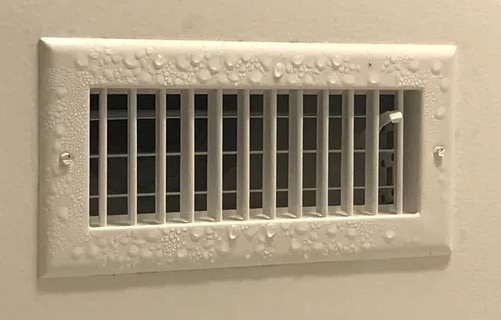
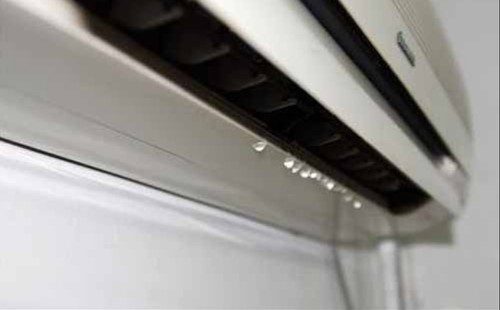
- Low airflow – The airflow of the air conditioner feels significantly lesser or a higher fan speed setting is needed than before.
- No hot air infiltration – Doors and windows are shut. Hot air coming into the air-conditioned space is unlikely.
Causes
- Dirty air filter – The air filter of the air conditioner is full of dust.
- Dirty cooling coil – The cooling coil at the indoor unit of the air conditioner is full of dust.
- Dirty duct – The supply or return air duct is full of dust.
- Filter or return air grille is blocked – Foreign objects such as plastic bags and paper stuck on the air filter of the air conditioner or stick onto the return air grille.
- Closed dampers (ducted unit) – The damper of the supply or return air grille or both are fully or partially closed, too much airflow is reduced. See the below video example:
- Worn fan motor – Fan motor is worn, slowing down the fan or blower.
How to Fix
- Clean the air filter – Wash off the dust on the air filter of the air conditioner using water.
- Clean the cooling coil – Use water or chemical to clean the cooling coil. DIY is feasible.
- Clean the duct – Duct cleaning mostly required a professional to do using a small robot and it can be costly.
- Remove air blockages – Check the return air grille if it is blocked and remove the blockages.
If the above still can’t bring the airflow back to normal, check the dampers setting if it closed too much. Otherwise, check the running current of the fan motor using a clamp meter to compare with the motor specified ampere range. Seek a professional if needed.
Prevention
- Clean the filter regularly – Periodically wash off the dust on the air conditioner of the air conditioner to maintain good airflow and significantly reduces the build-up of dust on the cooling coil and the inside of the ducts.
- Avoid potential blockages – Try not to put lightweight objects such as paper, plastic bags, and tissue near to the return air grilles to prevent them from sucking into the grilles and blocked them.
Fan motor worn out over time. But, a good quality air conditioner shall have a fan motor that can last for many years. Air blockages put stress on the fan motor and reduce its lifespan. Thus, clean the air filter and cooling coil regularly to prolong the lifespan of the fan motor.
3. Poor Insulation
Air conditioning systems required good insulation to prevent condensation. Poor insulation work will cause water droplets to form on cold surfaces and drips.
Symptoms
- Water droplets formed and dripping – Water droplets formed around the refrigerant pipe, drain pipe, or below the air conditioner. The water droplets may be dripping.
- Watermarks on ceiling or wall/floor – Watermarks can be seen on the ceiling, wall/floor where the refrigerant pipe is concealed.
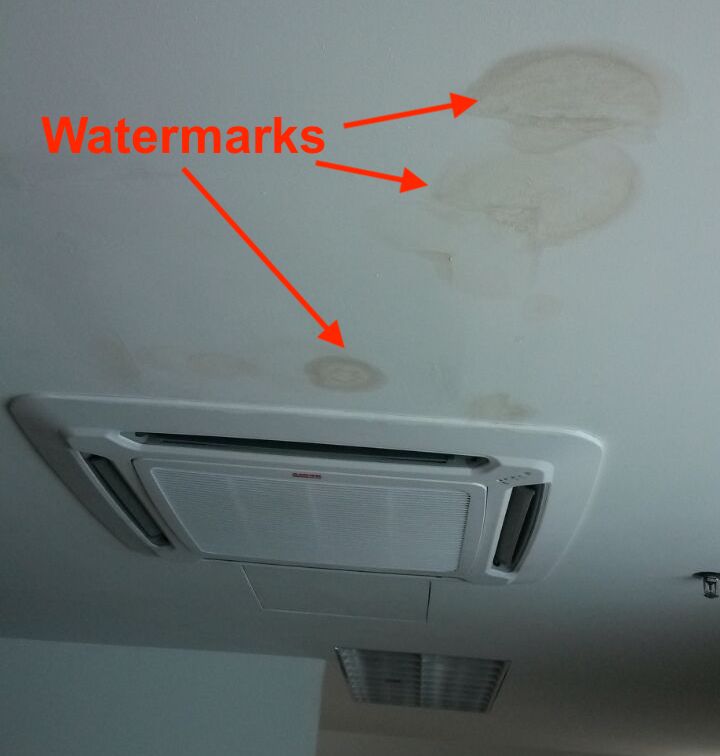

Causes
- Poor insulation work – The insulation of the refrigerant pipe, drain pipe, secondary drain pan, or the internal pipes of the air conditioner is not complete or insufficient thickness, causing condensate.
- Old insulation – The insulation aged, losses its performance, and unable to prevent condensation.
How to Fix
- Wrap more insulation – Put insulation on pipes or sections where there are water droplets to insulate and stop the condensation.
- Replace the insulation – Replace old or broken insulation to stop the condensation. See below video on how to replace the insulation:
Prevention
- Hire a good installer – Workmanship determines if an air conditioning system is well-insulated.
- Ensure sufficient insulation thickness – Different operating conditions required different insulation thickness. Seek advice from a qualified installer, air conditioner manufacturer, or copper pipe supplier.
4. Hot Air Infiltration
Hot air infiltration meaning that there is an infiltration of warm/hot air into the air conditioning system. When hot air contacts with cold surfaces, mild to severe condensation issue occurs.
Symptoms
- Water droplets formed and dripping – Water droplets formed at diffusers or supply air outlets. The water droplets may be dripping.
- Happen mostly during the day – Water droplets formed or dripped severely during the day but less or not at night.

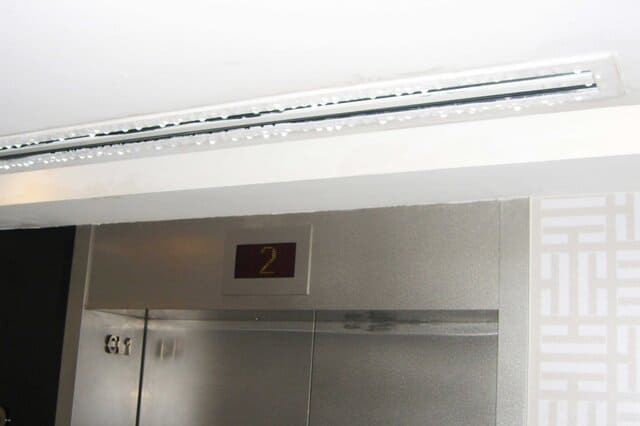
Causes
- Condensation – Hot air came into contact with cold surfaces. Water vapor in the air changed into liquid water on cold surfaces such as diffusers or supply air outlets.
How to Fix
- Close doors and windows – Prevent outside hot air from entering and contact with cold surfaces to stop the condensation.
- Stop infiltrations – Seal off any holes/gaps that allow outside hot air to enter and contact the air conditioners, supply air ducts, or supply air diffusers. See the below video on how to patch wall holes:
Prevention
- Install door closers – Put door closers to close the door automatically, ensuring doors are always closed and prevent outside hot air from entering.
- Install air curtains – Use air curtains to form an invisible wall between the air-conditioned space and outside to prevent outside hot air from entering.
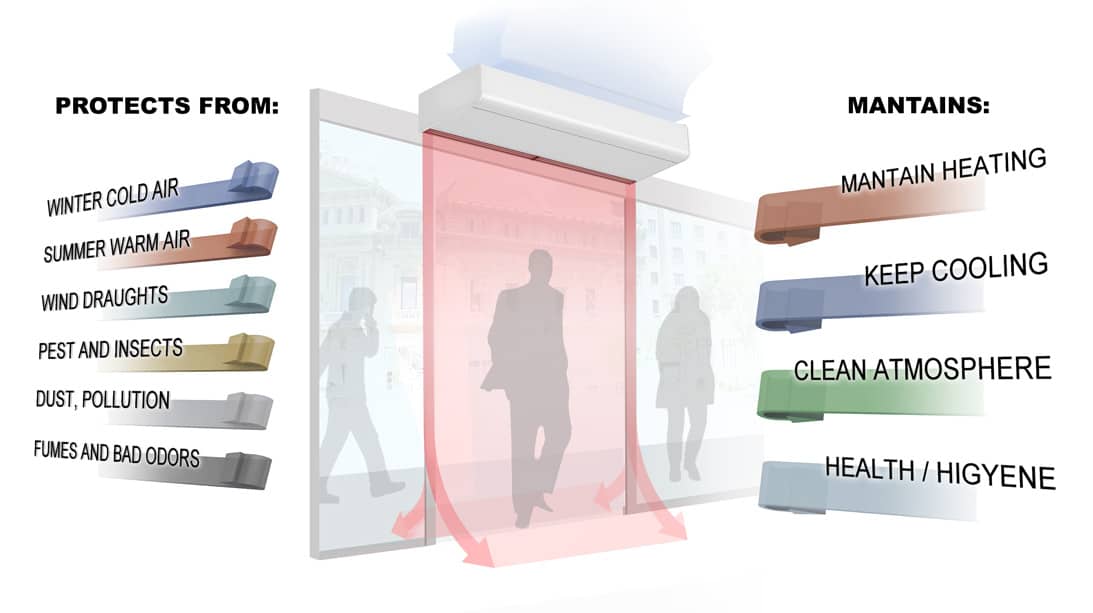
- Install fresh air ducts – Attach a fresh air duct to the air conditioner to provide sufficient oxygen while closing all windows. Must check if the air conditioner is compatible.
5. Low Refrigerant
Air conditioners are required to operate with a certain amount of refrigerant. The amount of refrigerant required usually based on the manufacturer’s recommendation and the operating condition of the air conditioner.
Symptoms
- No water droplets – Water droplets not found at diffusers or supply air outlets.
- Water is dripping from the inside of the air conditioner – Water dripping from the inside of the air conditioner but water droplets not seen on the surface of the air conditioner.
- Not cooling – No cold air or the air conditioner stop working.
- Frozen cooling coil – Air conditioner cooling coil freeze up. See the below photo:
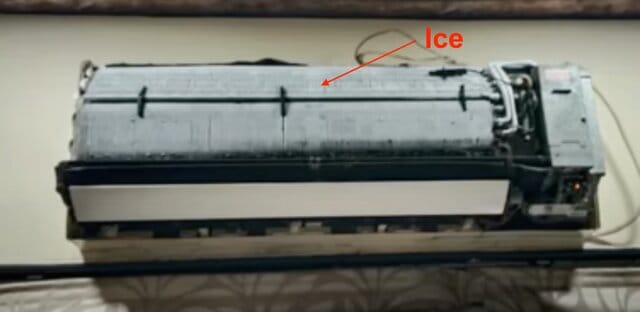
Causes
- Defective copper pipe joint – A copper pipe joint is not tight, causing a refrigerant leaking.
- Copper pipe cracks – A section of the copper pipe has a crack and it is leaking refrigerant.
- Defective air conditioner – The cooling coil of the air conditioner is defective and it is leaking refrigerant.
How to Fix
A professional is recommended to fix a leaking copper pipe:
- Redo the pipe joint – Open and connect the copper pipe joint properly.
- Seal the pipe crack – Solder or braze the copper pipe crack to seal the leakage.
- Replace the pipe – Replace a section of the copper pipe if it is irreparable.
- Replace the air conditioner – Replace a new air conditioner as per the following:
For defective air conditioner:
- Claim warranty – Contact the manufacturer to claim for a new unit.
- Repair the cracks – Dismantle the cooling coil and repair the crack. A professional may be required. Check if the repair cost is worth it or buy a new unit instead.
After the leakage has been found and sealed, vacuum the copper pipe properly and refill the refrigerant up to the manufacturer’s recommended pressure. A professional is recommended.
Prevention
- Pressure test – Perform a pressure test before filling up the copper pipe with refrigerant.
- Hire a good installer – Refrigerant leaks are very costly to repair. Be sure to hire a good installer.
6. Defective Drain Pipe
A drain pipe may not show signs of leakages right after a defective installation. Water leaking can occur in a few days after the installation.
Symptoms
- Water leaking not from the indoor unit – Water is not leaking from the indoor unit but outside of the indoor unit.
- Water leaks along the drain pipe – Water is leaking and it is falling down along the surface of the drain pipe.
- Watermark on the wall/floor – Watermark is visible on the wall/floor where the drain pipe is concealed.
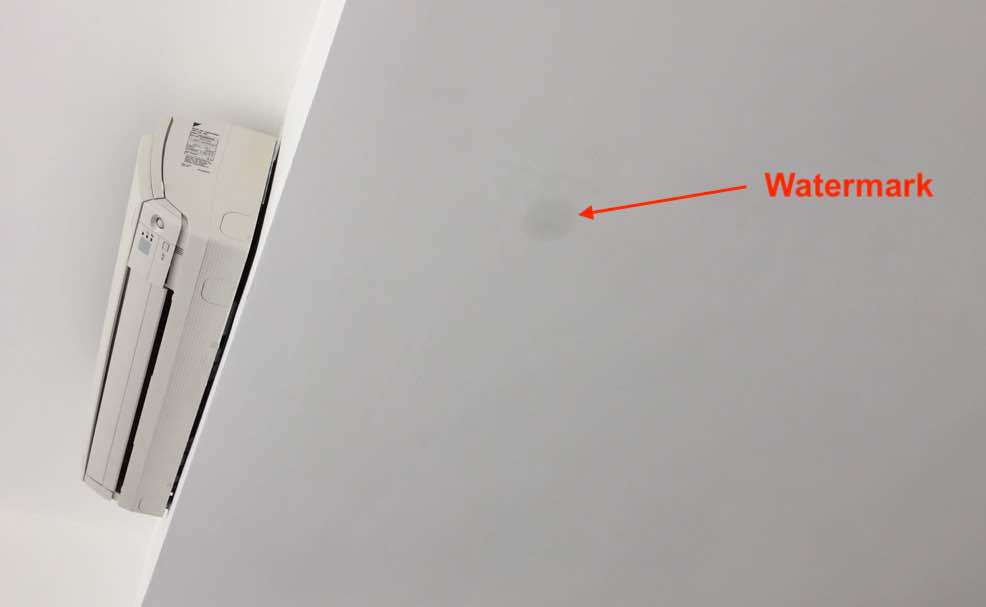
Causes
- Defective drain pipe joints – The drain pipe was not jointed properly and water is sipping out from the joint.
- Defective drain pipes – The drain pipe itself is cracked and leaking water.
How to Fix
- Rectify the leaking joint – Tighten or redo and make good the leaking joint.
- Replace the broken pipes – Replace a section of the cracked pipe. It is advisable to run a new drain pipe if the leaking section is concealed due to the high repair cost.
Prevention
- Flow test – Perform flow test to the drain pipe after the installation by pouring water to check if any leakages.
- Hire a good installer – Drain pipes installed with a good workmanship can last for many years.
7. Drain Pump Faulty
Certain types of air conditioner such as the ceiling cassette has a built-in drain pump. A drain pump also can be found beside a wall-mounted air conditioner when it is not possible for the condensate water to discharge by gravity.
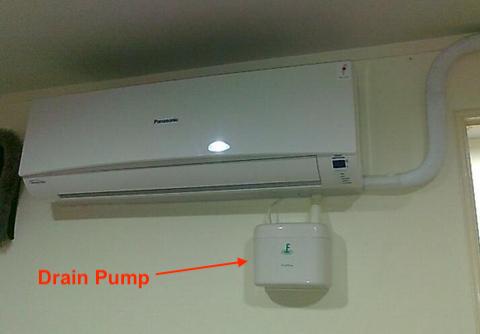
Symptoms
- Water leaking continuously from the indoor unit – Condensate water overflowed at the indoor unit. Water leaking continues even after the air conditioner is turned off.
- Drain pump has no sound – No sound can be heard from the drain pump where it usually has.
Causes
- Faulty drain pump – The drain pump is broken. Hence, condensate water is not pumped out of the air conditioner.
Prevention
- Quality of the drain pump – Use a drain pump from a reputable brand/manufacturer.
Drain pumps are easily broken or not working if there is not enough positive suction pressure. So, we need to make sure that there is always some water at the inlet of the drain pump to exert a small pressure on the drain pump motor. Thus, always place the drain pump lower than the wall-mounted air conditioner so that the condensate water flows to the drain pump first.
8. Rusted Drain Pan (Mostly Central AC)
Air conditioners have a drain pan to collect condensate water before channeling it to the drain pipe. Old air conditioners may have a rusty drain pan.
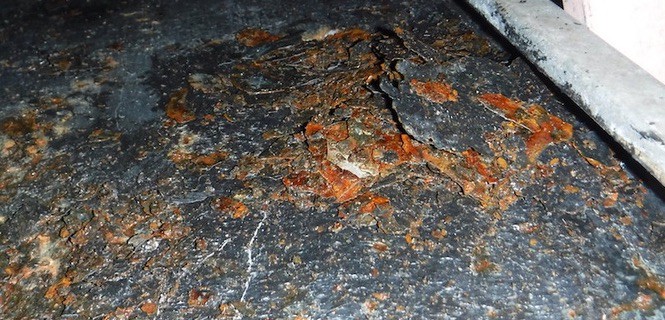
Symptoms
- Water is dripping slowly – Water dripping slowly below the air conditioner
- Water is brownish in color – Water leaks from the air conditioner is brownish in color
Causes
- Rusted drain pan – The built-in drain pan or secondary drain pan rusted and has a hole that is leaking water.
How to Fix
- Seal the leaking hole – Paste the hole using sealants, tapes, or other waterproof materials. See the below video:
- Replace the drain pan – If the drain pan is severely rusted, it is advisable to replace a new one. Ceiling dismantling work may be required and it is costly.
Prevention
Drain pans rust over time. However, dirty water corrodes and accelerates it. Therefore, we can prolong the lifespan of the drain pan by keeping the condensate water clean which means that we should was the filter of the air conditioner regularly.
If you have anything to add (or ask) about this topic, leave a comment down below!


